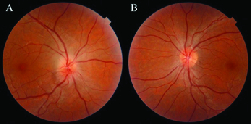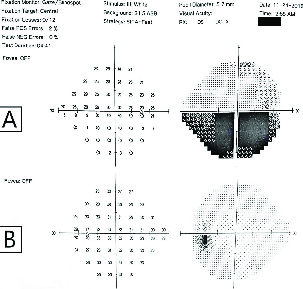Abstract
Background
Clomiphene citrate is an estrogen receptor ligand with mixed agonistic–antagonistic properties used for the treatment of female and male infertility. Various visual disturbances and several irreversible visual outcomes have been associated with clomiphene citrate. In this report, we present a patient with presumed clomiphene-induced optic neuropathy.
Case
A 33-yr-old man with acute visual loss of the right eye was referred to Amiralmomenin Hospital, Rasht, Iran in November 2018. His only medication was clomiphene citrate 100 mg daily, taken for 2 wk for fertility issues. The patient presented with a sudden decrease of visual acuity in the right eye on the 14 day of starting the treatment and subsequently developed complete loss of inferior visual field within a few days. On examination, the visual acuity was 6/20 in the right and 20/20 in the left eyes, with a right relative afferent pupillary defect and decreased red color saturation. The fundus examination revealed optic disc swelling with venous dilation in the right eye and a normal left fundus with a crowded disc (disc-at-risk). The patient was evaluated for systemic disorders, all of which were normal. Findings were suggestive of non-arteritic anterior ischemic optic neuropathy most likely due to clomiphene.
Conclusion
As clomiphene may increase blood viscosity, it is hypothesized that reduced flow in a posterior ciliary artery in conjunction with the disc-at-risk contributes to the anterior ischemic optic neuropathy. It is advised that patients with disc-at-risk be aware of the possible non-arteritic anterior ischemic optic neuropathy and those experiencing visual symptoms while taking clomiphene be examined promptly for evidence of optic nerve injury.
Keywords: Clomiphene citrate, Optic neuropathy, Visual acuity, Ischemia.
1. Introduction
Clomiphene citrate is an estrogen receptor ligand with mixed agonistic–antagonistic properties used for the treatment of female and male infertility (1). Clomiphene binds to the estrogen receptors on the hypothalamus, thus inhibiting normal estrogenic negative feedback and inducing testosterone production and spermatogenesis (2). Several visual side effects have been reported with increased dosage and duration of therapy with clomiphene (3, 4). A number of irreversible visual disturbances have also been associated with clomiphene citrate (5).
In this report, we present a patient with presumed clomiphene-induced optic neuropathy.
2. Case Presentation
A 33-yr-old man presented with decreased vision of the right eye referred to Amiralmomenin Hospital, Rasht, Iran in November 2018. His symptoms were not accompanied by any other ocular symptoms. The patient had no relevant family history or prior ophthalmological problems or head trauma/injury. He had no significant medical history, including diabetes mellitus and hypertension, and no history of smoking. He had been treated with clomiphene citrate 100 mg for 2 wk for infertility issues. The patient presented with a sudden decrease of visual acuity in the right eye on the 14 day of taking the treatment and subsequently developed complete loss of inferior visual field in a few days. He had no history of other medicine or herbal intake.
At initial presentation, his best-corrected visual acuity was 6/20 in the right and 20/20 in the left eyes, with a right relative afferent pupillary defect and decreased red color saturation. The intraocular pressure was 13 and 11 mmHg in the right and left eyes, respectively. Extraocular movements were normal in both eyes. The slit-lamp examination of the anterior segment and anterior vitreous were unremarkable in both eyes. The fundus copy of the right eye revealed a swelling of the optic nerve head with blurred margin, especially in the superior pole pallor, and venous congestion was noted. The macula seemed to be normal. Fundus copy of the left eye showed a small cup–disc ratio of 0.2 without any other pathological findings (Figure 1). Based on these findings, immediate neurologic consultation was performed and brain and orbital MRI and computer tomography were obtained, which showed no pathologic findings. Cardiologic examinations including carotid ultrasound and blood pressure monitoring were also unremarkable. Further serologic studies for infection and hypercoagulable states (complete blood count, thyroid hormone levels, erythrocyte sedimentation rate, C-reactive protein, angiotensin-converting enzyme, toxoplasmosis antibodies, antithrombin III, factor V Leiden, protein C, protein S, anti-phospholipid antibody, and lupus anticoagulant) were evaluated. All laboratory tests were within the normal range.
Perimetry by a Humphrey Visual Field Analyzer (24-2 threshold program) revealed an absolute inferior altitudinal visual field deficit in the right eye and a normal visual field in the left eye (Figure 2). Optical coherence tomography of the optic nerve showed thickening of the nerve fiber layer of the right eye and the macular optical coherence tomography revealed no significant changes.
Physical examination and complementary evaluations were suggestive of non-arteritic anterior ischemic optic neuropathy (NAION) of the right eye. Considering the normal laboratory and cardiologic findings and that the patient had been taking clomiphene citrate, it was concluded that clomiphene citrate was accountable for the anterior ischemic optic neuropathy. The patient was asked to discontinue clomiphene citrate. Three months later despite the drug discontinuation, the visual acuity was 10/20 in the right eye with a relative afferent pupillary defect and superior disc pallor, with a persistent inferior altitudinal visual field defect.
Figure 1.

Fundus photograph: (A) Disc swelling and hyperemia in the right fundus and (B) A small cup-disc ratio in the left fundus.
Figure 2.

SITA Standard 24-2 Perimetry: (A) Right eye with an absolute inferior altitudinal visual field deficit and (B) A normal visual field in the left eye.
Ethical considerations
The case report was fully explained to the patient and written consent was obtained to authorize the authors to write and publish a case report.
3. Discussion
NAION is a common optic neuropathy occurring generally in adults over 50 yr (6). Although not well-understood, several mechanisms have been mentioned regarding ischemia. Arteriosclerosis with or without thrombosis and embolization reduces blood flow of the short posterior ciliary arteries; however, it is believed that in some cases the condition is due to generalized hypoperfusion. The inflexible structure of the optic disc has also been associated with NAION, thus suggesting a compartment syndrome as a mechanism (7). Patients with a small cup–disc ratio, also known as disc-at-risk, are also prone to NAION. Nearly all cases have at least one vascular risk factor that contributes to NAION. A number of medications have been linked with the development of NAION including interferon-alpha, phosphodiesterase inhibitors, and amiodarone (6).
Clomiphene citrate is a nonsteroidal drug with both estrogenic and antiestrogenic activity (1). It is the treatment of choice for women with anovulatory infertility and has also been used for the treatment of male infertility. Reported side effects include headache, dizziness, nausea, vomiting, gynecomastia, hypertension, pancreatitis, myocardial infarction, deep vein thrombosis, pulmonary embolism, and hypertriglyceridemia (2). Increased dosage and duration of therapy with this drug has been associated with several visual side effects (8). Visual problems such as decreased vision, diplopia, photophobia, scotomata, periphlebitis, and retinal vein occlusions have been reported in the literature (4, 9–12). Clomiphene therapy causes the release of pituitary gonadotropins followed by an increase in thrombogenic estradiol which increases blood viscosity and the likelihood of blood to coagulate. The probable increase in blood viscosity and coagulation predispose patients to vascular-related incidents.
In the present case, it is hypothesized that reduced blood flow in a posterior ciliary artery in conjunction with the disc-at-risk contributed to the anterior ischemic optic neuropathy. Our patient was an otherwise healthy young man with no prior vascular risk factor and denied the use of any medication apart from clomiphene. To the best of our knowledge, two reports of clomiphene-associated NAION have been documented so far (13, 14). Similar to the present case, in both of these cases, clomiphene was the sole drug used and patients had no related underlying disease. Infertility specialties and ophthalmologists must be cautious of the possible optic nerve injury in connection with clomiphene citrate. Therefore, we suggest that before starting treatment, a careful ophthalmic examination should be carried out and patients with the disc-at-risk should be informed about the increased possibility of NAION occurrence. Also, patients experiencing visual symptoms while taking clomiphene must be examined promptly for evidence of visual changes or optic nerve injury.
4. Conclusion
As NAION is an irreversible cause of visual loss, special consideration must be given when prescribing clomiphene citrate. It is recommended that patients undergo ophthalmic examination prior to clomiphene initiation and those under treatment with clomiphene should be examined promptly if they experience visual disturbances.
Conflict of Interest
None declared.
Acknowledgements
The authors would like to thank the staff at Amiralmomenin Hospital, Rasht, Iran for image acquisition.
References
- 1.Willets AE, Corbo JM, Brown JN. Clomiphene for the treatment of male infertility. Reprod Sci 2013; 20: 739–744. [DOI] [PubMed]
- 2.Wheeler KM, Sharma D, Kavoussi PK, Smith RP, Costabile R. Clomiphene citrate for the treatment of hypogonadism. Sex Med Rev 2018; 7: 272–276. [DOI] [PubMed]
- 3.Racette L, Casson PR, Claman P, Zackon DH, Casson EJ. An investigation of the visual disturbances experienced by patients on clomiphene citrate. Fertil Steril 2010; 93: 1169–1172. [DOI] [PubMed]
- 4.Viola MI, Meyer D, Kruger T. Association between clomiphene citrate and visual disturbances with special emphasis on central retinal vein occlusion: A review. Gynecol Obstet Invest 2011; 71: 73–76. [DOI] [PubMed]
- 5.Russom M, Pradeep B, Zeregabr M, Fessehatzion K, Araya N. Blindness and retinal disorder associated with clomifene citrate: Cases series assessment. Clin Med Invest 2017; 2: 1–4.
- 6.Miller NR, Arnold AC. Current concepts in the diagnosis, pathogenesis and management of nonarteritic anterior ischaemic optic neuropathy. Eye 2015; 29: 65–79. [DOI] [PMC free article] [PubMed]
- 7.Kaup M, Plange N, Arend KO, Remky A. Retrobulbar haemodynamics in non-arteritic anterior ischaemic optic neuropathy. Br J Ophthalmol 2006; 90: 1350–1353. [DOI] [PMC free article] [PubMed]
- 8.Purvin VA. Visual disturbance secondary to clomiphene citrate. Arch Ophthalmol 1995; 113: 482–484. [DOI] [PubMed]
- 9.Lee VYW, Liu DTL, Li CL, Lam DSC. Central retinal vein occlusion associated with clomiphene-induced ovulation. Fertil Steril 2008; 90: 2011. e11–e12. [DOI] [PubMed]
- 10.Roch LM, Gordon DL, Barr AB, Paulsen CA. Visual changes associated with clomiphene citrate therapy. Arch Ophthalmol 1967; 77: 14–17. [DOI] [PubMed]
- 11.Rock T, Dinar Y, Romem M. Retinal periphlebitis after hormonal treatment. Ann Ophthalmol 1989; 21: 75–76. [PubMed]
- 12.Venkatesh R, Gujral GS, Gurav P, Tibrewal S, Mathur U. Clomiphene citrate-induced visual hallucinations: A case report. J Med Case Reports 2017; 11: 1–3. [DOI] [PMC free article] [PubMed]
- 13.Lawton AW. Optic neuropathy associated with clomiphene citrate therapy. Fertil Steril 1994; 61: 390–391. [DOI] [PubMed]
- 14.Perin AF, Chacko JG, Goyal S. Nonarteritic ischemic optic neuropathy associated with clomiphene citrate use. J Neuroophthalmol 2017; 37: 106–107. [DOI] [PubMed]


